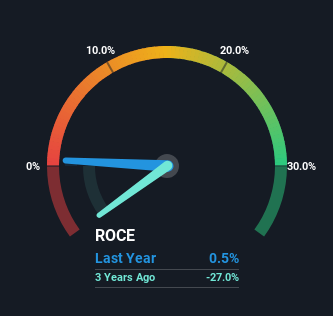We Like These Underlying Return On Capital Trends At Kimuratan (TSE:8107)
Finding a business that has the potential to grow substantially is not easy, but it is possible if we look at a few key financial metrics. One common approach is to try and find a company with returns on capital employed (ROCE) that are increasing, in conjunction with a growing amount of capital employed. Put simply, these types of businesses are compounding machines, meaning they are continually reinvesting their earnings at ever-higher rates of return. So on that note, Kimuratan (TSE:8107) looks quite promising in regards to its trends of return on capital.
Return On Capital Employed (ROCE): What Is It?
If you haven't worked with ROCE before, it measures the 'return' (pre-tax profit) a company generates from capital employed in its business. The formula for this calculation on Kimuratan is:
Return on Capital Employed = Earnings Before Interest and Tax (EBIT) ÷ (Total Assets - Current Liabilities)
0.0052 = JP¥46m ÷ (JP¥10b - JP¥1.3b) (Based on the trailing twelve months to September 2024).
Thus, Kimuratan has an ROCE of 0.5%. In absolute terms, that's a low return and it also under-performs the Luxury industry average of 4.6%.
View our latest analysis for Kimuratan

Historical performance is a great place to start when researching a stock so above you can see the gauge for Kimuratan's ROCE against it's prior returns. If you want to delve into the historical earnings , check out these free graphs detailing revenue and cash flow performance of Kimuratan.
What Can We Tell From Kimuratan's ROCE Trend?
Kimuratan has recently broken into profitability so their prior investments seem to be paying off. The company was generating losses five years ago, but now it's earning 0.5% which is a sight for sore eyes. And unsurprisingly, like most companies trying to break into the black, Kimuratan is utilizing 401% more capital than it was five years ago. We like this trend, because it tells us the company has profitable reinvestment opportunities available to it, and if it continues going forward that can lead to a multi-bagger performance.
On a related note, the company's ratio of current liabilities to total assets has decreased to 13%, which basically reduces it's funding from the likes of short-term creditors or suppliers. So shareholders would be pleased that the growth in returns has mostly come from underlying business performance.
The Bottom Line
Overall, Kimuratan gets a big tick from us thanks in most part to the fact that it is now profitable and is reinvesting in its business. Since the stock has only returned 3.4% to shareholders over the last five years, the promising fundamentals may not be recognized yet by investors. Given that, we'd look further into this stock in case it has more traits that could make it multiply in the long term.
If you want to know some of the risks facing Kimuratan we've found 3 warning signs (1 is a bit concerning!) that you should be aware of before investing here.
For those who like to invest in solid companies, check out this free list of companies with solid balance sheets and high returns on equity.
Valuation is complex, but we're here to simplify it.
Discover if Kimuratan might be undervalued or overvalued with our detailed analysis, featuring fair value estimates, potential risks, dividends, insider trades, and its financial condition.
Access Free AnalysisHave feedback on this article? Concerned about the content? Get in touch with us directly. Alternatively, email editorial-team (at) simplywallst.com.
This article by Simply Wall St is general in nature. We provide commentary based on historical data and analyst forecasts only using an unbiased methodology and our articles are not intended to be financial advice. It does not constitute a recommendation to buy or sell any stock, and does not take account of your objectives, or your financial situation. We aim to bring you long-term focused analysis driven by fundamental data. Note that our analysis may not factor in the latest price-sensitive company announcements or qualitative material. Simply Wall St has no position in any stocks mentioned.
About TSE:8107
Kimuratan
Plans, produces, and sells baby and children’s clothing in Japan.
Mediocre balance sheet and slightly overvalued.
Market Insights
Community Narratives




